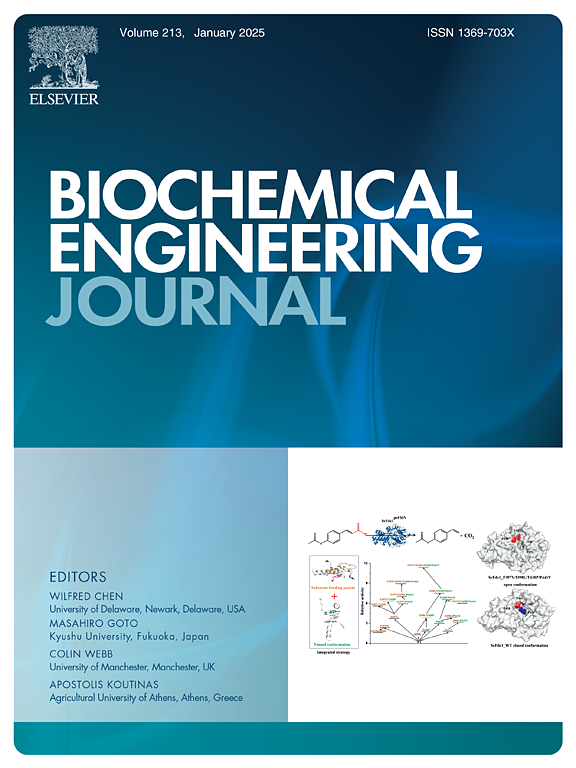Developing a rapid COD detection method based on the fusion strategy of multi-depth hyperspectral data
IF 3.7
3区 生物学
Q2 BIOTECHNOLOGY & APPLIED MICROBIOLOGY
引用次数: 0
Abstract
COD is a key indicator for evaluating the concentration of organic pollutants in wastewater as well as water quality monitoring. At present, COD detection methods have shortcomings such as long detection time, complicated detection process and high consumption of chemical agent. In this paper, a rapid detection method for COD in wastewater is proposed based on a multi-depth hyperspectral data fusion strategy (using hyperspectral data from sampling sites at multiple depths). In the method, the triangular prism acquisition method is proposed to acquire multi-depth hyperspectral data, and the bilateral filtering algorithm is introduced to reduce noise. The hyperspectral data acquired from sampling sites with three water depths (5 mm, 10 mm, and 15 mm) is analyzed by the random forest algorithm (RF), and two data fusion strategies are applied at the data level (the low-level fusion) and the feature level (the mid-level fusion). The results demonstrate that the modeling performance of the fused hyperspectral data is superior to that of the non-fused hyperspectral data. The lower-level fused data, combined with the competitive adaptive reweighted sampling (CARS) algorithm, produced a model capable of accurately predicting COD concentrations (= 0.9312, RMSEP= 526.9, RPD= 3.54). This approach provides an environmentally friendly and efficient method for quantitative COD detection in wastewater.
基于多深度高光谱数据融合策略的COD快速检测方法
COD是评价废水中有机污染物浓度和水质监测的关键指标。目前的COD检测方法存在检测时间长、检测过程复杂、化学药剂消耗量大等缺点。本文提出了一种基于多深度高光谱数据融合策略(利用多深度采样点的高光谱数据)的废水COD快速检测方法。该方法采用三角棱镜采集法获取多深度高光谱数据,并引入双边滤波算法降低噪声。采用随机森林算法(RF)对水深为5 mm、10 mm和15 mm的3个采样点的高光谱数据进行分析,并在数据级(低级融合)和特征级(中级融合)上采用两种数据融合策略。结果表明,融合后的高光谱数据建模性能优于未融合的高光谱数据。将较低层次的融合数据与竞争自适应重加权采样(CARS)算法相结合,得到了能够准确预测COD浓度的模型(Rp2= 0.9312, RMSEP= 526.9, RPD= 3.54)。该方法为废水中COD的定量检测提供了一种环保高效的方法。
本文章由计算机程序翻译,如有差异,请以英文原文为准。
求助全文
约1分钟内获得全文
求助全文
来源期刊

Biochemical Engineering Journal
工程技术-工程:化工
CiteScore
7.10
自引率
5.10%
发文量
380
审稿时长
34 days
期刊介绍:
The Biochemical Engineering Journal aims to promote progress in the crucial chemical engineering aspects of the development of biological processes associated with everything from raw materials preparation to product recovery relevant to industries as diverse as medical/healthcare, industrial biotechnology, and environmental biotechnology.
The Journal welcomes full length original research papers, short communications, and review papers* in the following research fields:
Biocatalysis (enzyme or microbial) and biotransformations, including immobilized biocatalyst preparation and kinetics
Biosensors and Biodevices including biofabrication and novel fuel cell development
Bioseparations including scale-up and protein refolding/renaturation
Environmental Bioengineering including bioconversion, bioremediation, and microbial fuel cells
Bioreactor Systems including characterization, optimization and scale-up
Bioresources and Biorefinery Engineering including biomass conversion, biofuels, bioenergy, and optimization
Industrial Biotechnology including specialty chemicals, platform chemicals and neutraceuticals
Biomaterials and Tissue Engineering including bioartificial organs, cell encapsulation, and controlled release
Cell Culture Engineering (plant, animal or insect cells) including viral vectors, monoclonal antibodies, recombinant proteins, vaccines, and secondary metabolites
Cell Therapies and Stem Cells including pluripotent, mesenchymal and hematopoietic stem cells; immunotherapies; tissue-specific differentiation; and cryopreservation
Metabolic Engineering, Systems and Synthetic Biology including OMICS, bioinformatics, in silico biology, and metabolic flux analysis
Protein Engineering including enzyme engineering and directed evolution.
 求助内容:
求助内容: 应助结果提醒方式:
应助结果提醒方式:


